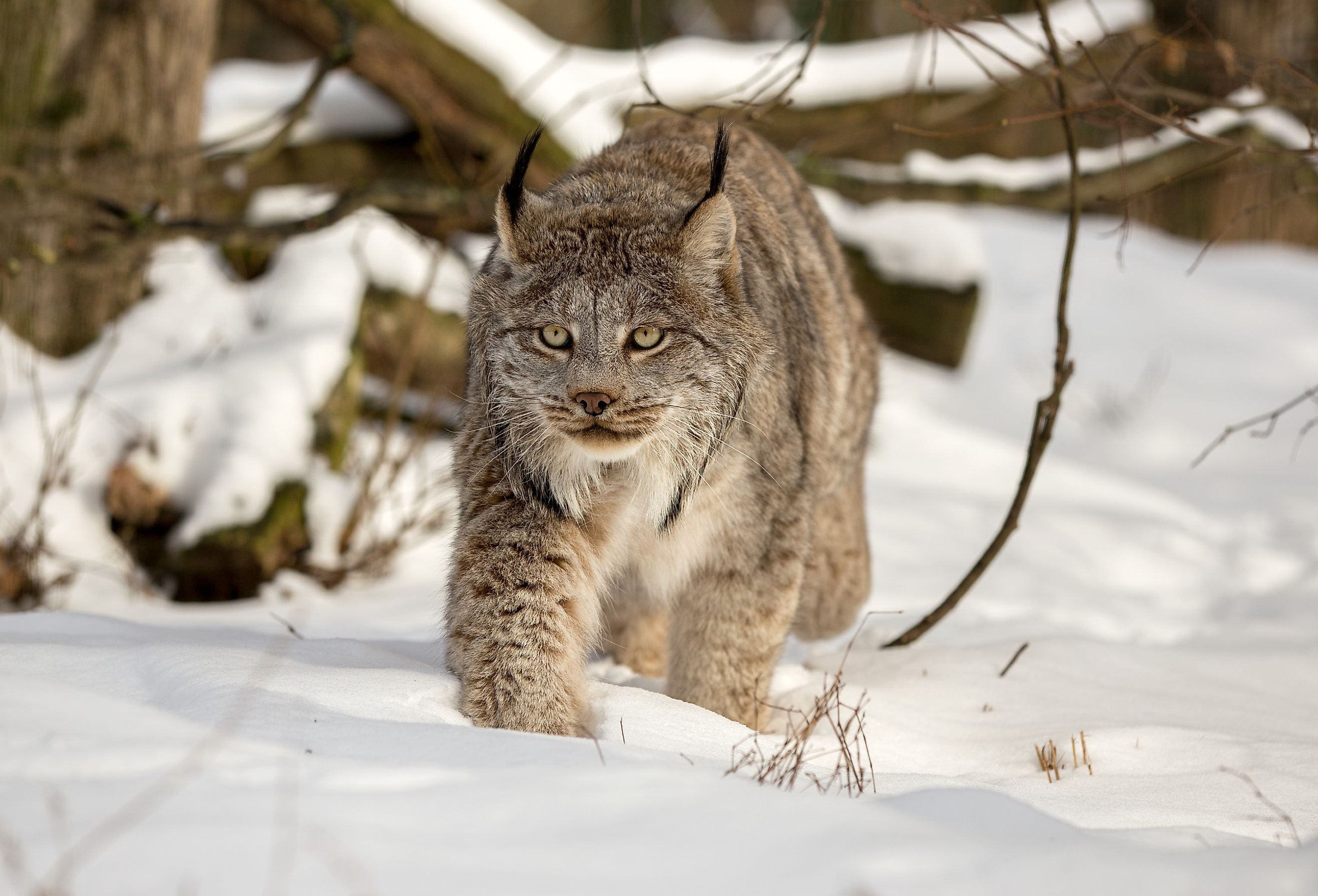
The 9 Coolest Animals In Canada
From the chilling cold of glaciers to the dark depths of the ocean, animals have adapted to all kinds of surroundings. With their unique characteristics, such as horns, fur, beaks, and more, the animal kingdom is the epitome of diversity. Many animals have become quite cool for a variety of reasons. For example, Canada, a large country spanning 3,855,100 square miles (9.985 million square km) with many different biomes, from tundra, boreal forest, and grassland to temperate deciduous forest, boasts an array of popular creatures. From the magnificent moose to the friendly beaver, each of these animals has their own set of characteristics that make them famous. Discover some of the coolest animals in Canada and what makes them so special.
Moose (Alces alces)
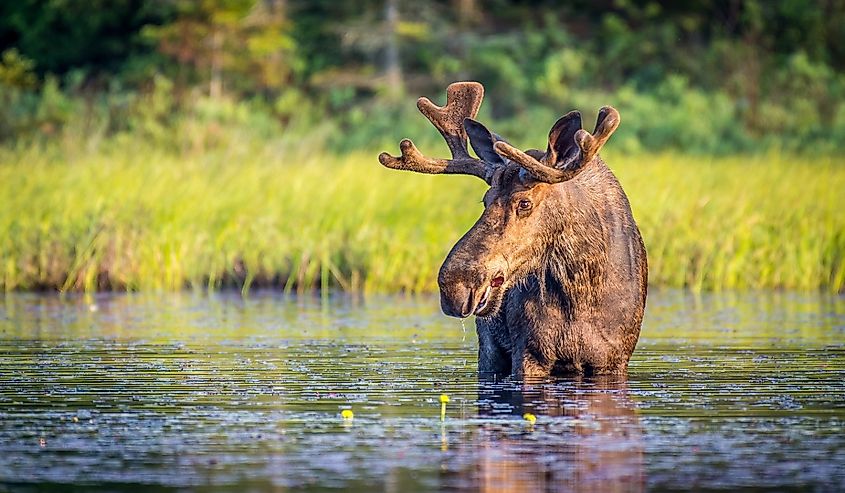
Starting with a bang, moose are the largest members of the deer family and one of the most popular animals in Canada. These huge mammals reach heights of up to 6 feet (1.8 meters) and can weigh more than 1,000 pounds (450 kilograms). Adding their dark brown hair and massive hooves creates a majestic creature few are able to mess with. To this end, adult moose are at the top of the food chain and can fight off large predators like bears and wolves. Thankfully, they aren’t always fighting, as moose are herbivores and prefer to eat leaves, shrubs, and twigs. This clean diet and lack of predators lead to a healthy lifespan of up to 12 years, after which symptoms of old age begin to show.
Canada is an important place for moose as it houses the largest population in the world. With more than 800,000 moose living in cold forests between Alaska and the eastern tip of Newfoundland and Labrador, this animal is a permanent member of this list. Canada's vast open space, coupled with conservative measures, ensures that these behemoth mammals are nowhere near extinction! That said, respecting the animal’s space and habitat is still important. Not only will this help keep them safe, but it will avoid startling moose, which can easily overpower a human.
North American beaver (Castor canadensis)
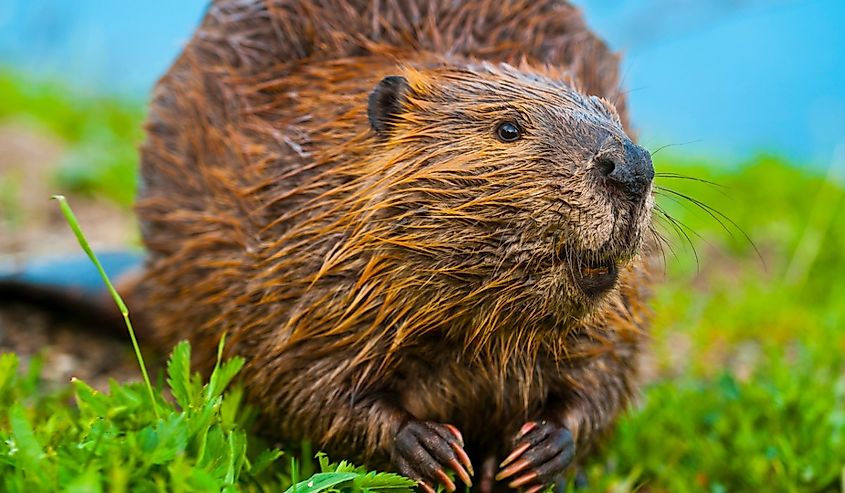
Named the national animal of Canada, there is no doubt that the North American beaver is a cool animal. Inhabiting most of Canada’s forested areas, this semiaquatic rodent lives in groups across the country. At first glance, they might seem quite unassuming with their stout body, soft fur, and length of less than 47 inches (120 cm). However, beavers have tons of unique quirks that make them popular. The first and most interesting is their habitat, a natural dam made of twigs, sticks, and small rocks. Beavers create strong dams with tedious effort. The dams maintain freshwater ecosystems and provide shelter under the water. These dams are perfect for these furry friends as they protect them from all sorts of predators throughout their 10-year lifespan. Moreover, beavers boast great underwater maneuverability and can stay submerged for up to eight minutes, so they have no trouble hiding! When not underwater, beavers love to snack on wood with their chisel-sharp teeth, perfect for trimming sticks. With so much work to do, it’s quite obvious where the saying "busy as a beaver" comes from!
Along with these features, beavers are some of the cutest rodents in North America, often mistaken as mammals. Whether it is their cute way of holding sticks with their hands or their fat belly, there is something special about the North American beaver.
Wolf (Canis lupus)
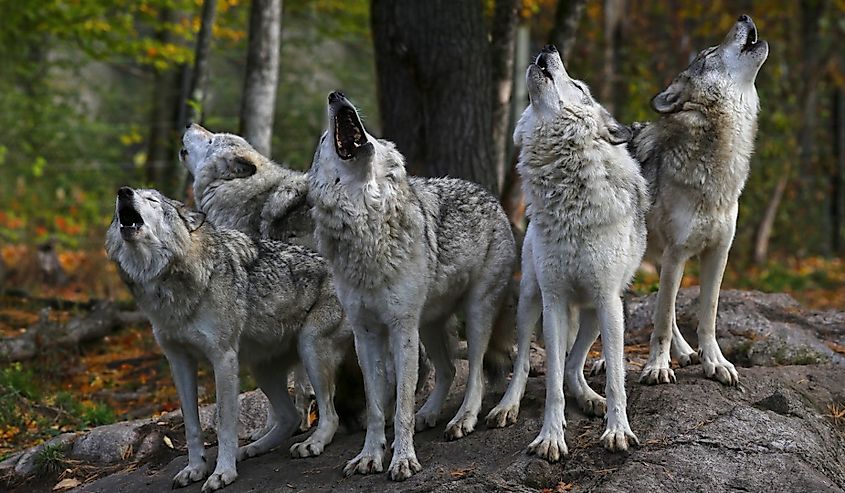
Wolves, the ancestors of our domesticated dogs, are some of the most fierce canines in Canada. Home to over 50,000 wolves of more than 10 species, Canada hosts the world’s largest wolf population. These furry creatures roam in large packs throughout the country in parks, forests, and preserves. Each pack features 6 to 10 individuals and is an amazing social structure unique to these animals. This is because they form complex relations, and all members follow an alpha pair (male and female). These packs act as a family, hunt together, care for each other, and manage a territory of up to 1,158 square miles (3,000 square kilometers).
Each individual wolf is also quite menacing, with a body weight of up to 143 lbs (65 kg) and a length of over 6.5 feet (2 meters). Add on their large canine teeth, sharp senses, and speed of up to 37 miles per hour (60 km/h), and you get an animal adapted to hunting. Using these features, wolves can hunt down all sorts of large animals, such as deer, elk, bison, and even moose! Even if they are ever in danger, their fur coat ranges from white to brown, which allows them to camouflage with their surroundings. So, with their sharp instincts and family structure, wolves are among Canada’s coolest animals.
American Bison (Bison bison)
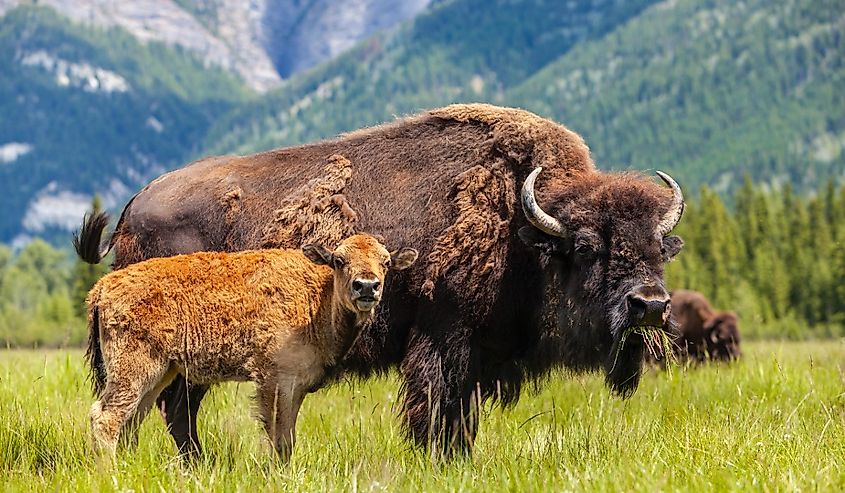
If you thought moose were large, the American bison is about to blow your mind. Standing at a weight of more than 900 kg (1,980 lbs) and a length of 3.7 m (12 ft), bison are the largest mammal in North America! They can easily be mistaken for small tanks due to their broad and heavy build covered with coarse brown fur. In Canada, these gentle giants once faced heavy hunting by indigenous hunters, which brought them close to extinction. Thankfully, since the late 1800s, the government has set up various measures to support and restore Bison populations. To this end, Canada has more than 12,000 Bison living across northern provinces.
Along with their large size, Bison are very athletic and can perform various tasks. For example, the average bull can run at speeds of up to 35 miles per hour ( 56 km/h) and jump over 6 feet (1.8 meters), which is more than some horses! Combine their speed with the set of C-shaped horns on their head, and you wouldn’t want to mess with a bison in the wild. To top it off, they have a long lifespan of over 15 years. Thanks to all this, these gentle giants are the national animal of the United States and one of Canada’s coolest.
Canadian Lynx (Lynx canadensis)
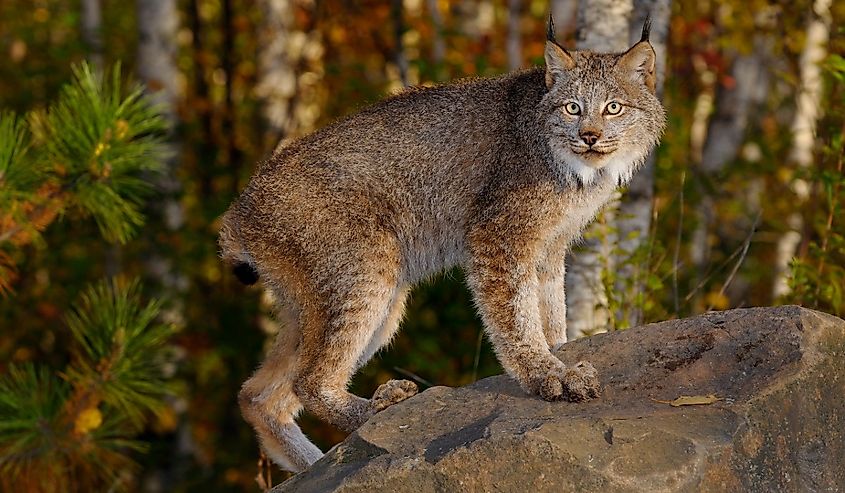
If feline ferociousness had a name, it would be the alluring Canadian lynx. Living in ranges across Canada, this cold-loving mammal is a specialist predator with many cool skills. To hunt its primary prey, the snowshoe hare, the Canadian Lynx can swim, climb, and run at a high caliber. So, scaling a tree, crossing a river, or chasing down hares at night are all trivial tasks. Along with this, the Canadian lynx is quite lean, weighing less than 37.5 lbs (17 kg) and reaching a maximum height of 22 inches (56 cm). Add on their dense grey-brown fur, and you get an animal that can easily hide from larger predators while being nimble enough for a chase.
In addition to their penchant for snowshoe hares, these big cats will also hunt ducks, moles, and young deer on occasion. As they often hunt at night, many of their prey are unable to react as fast in the dark, leading to a quick dispatch. Thanks to this, Canadian Lynx have managed to maintain a strong population in North America, and are currently listed as "Least Concern" conservation status. Bolstered by the abundance of dense boreal forests that they call home, most lynx can live for up to 10 years in the wild.
Monarch Butterfly (Danaus plexippus)
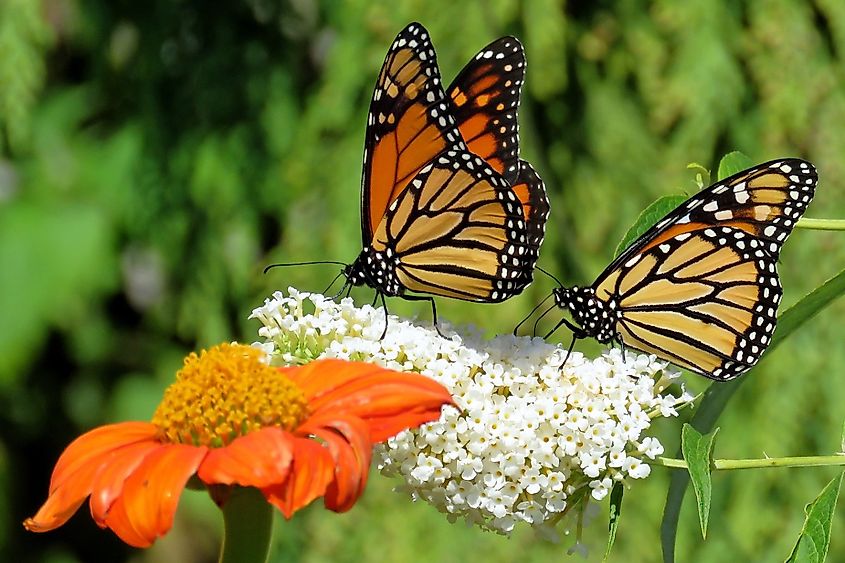
The monarch butterfly is by far one of the smallest cool animals in Canada, but still one of the most beautiful. Boasting bright orange and black wings, these butterflies shine like a monarchs amongst the rest. Moreover, with a large wingspan of 3.5 to 4 inches (9 to 10 cm), their design is a sight to behold. In Canada, the monarch butterfly lives in regions between Alberta and Newfoundland. Meanwhile, they have extensive breeding areas in southern Ontario and southern Quebec, as they are rich in nectar-filled plants.
While their visual appeal is second to none, the monarch butterfly is also revered for its immense migration. These tiny insects embark on a marvelous journey spanning between 1,200 and 2,800 miles (1,900 and 4,500 km) from North America to Central Mexico. With thousands of individuals making the trip, it is one of the largest migration events in the region and a lovely sight! Put it all together, and this small beauty is a top contender for Canada’s coolest.
Polar Bear (Ursus maritimus)
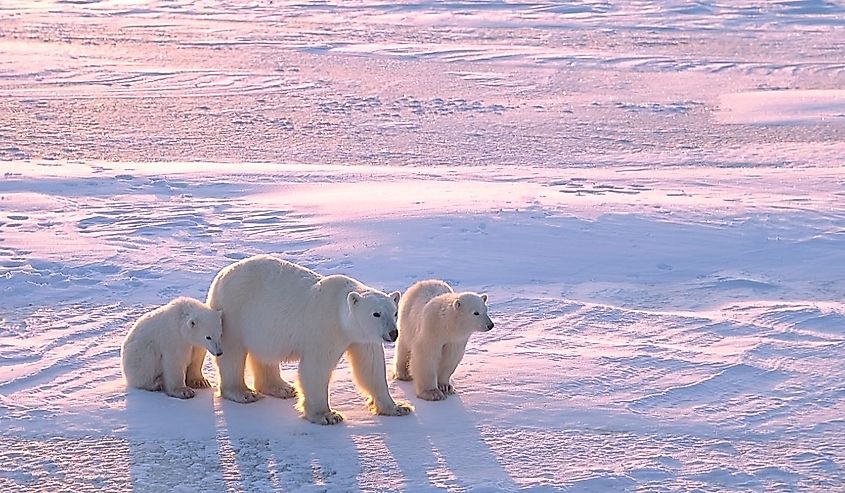
If your description of "cool" involves large animals, then the polar bear is sure to be one of your favorites. Reaching up to 1,734 pounds (800 kg), it is the largest extant species of bear and land carnivore. To this end, the polar bear is a force to be reckoned with and is one of the most vicious predators in its habitat; arctic areas. Here, these white bears use their strong build, sharp teeth, and large paws to hunt down seals, beluga whales, and reindeer. Along with their build, they are great swimmers and have a thick layer of fat that protects them from the cold. So, they can live and hunt in Canada’s chilling northern provinces, such as Manitoba, with ease.
Surprisingly, while being so popular, there are many interesting facts about polar bears that people miss, such as the fact that they aren’t white. Instead, these bears have black skin with translucent fur, and they only seem white due to the reflection of visible light! That said, people won’t get close enough to notice the difference, as a polar bear can smell prey up to 0.6 miles away. This helps them find seals and even surprise seals by hiding near their breathing holes. All this hunting does get them tired, and pregnant females will hibernate for 4 to 6 months before giving birth.
All in all, the polar bear is at the top of the Arctic food chain and one of nature’s coolest creations. So, it is important to keep an eye on these creatures to keep them safe from issues like global warming and industrialization.
Beluga Whale (Delphinapterus leucas)
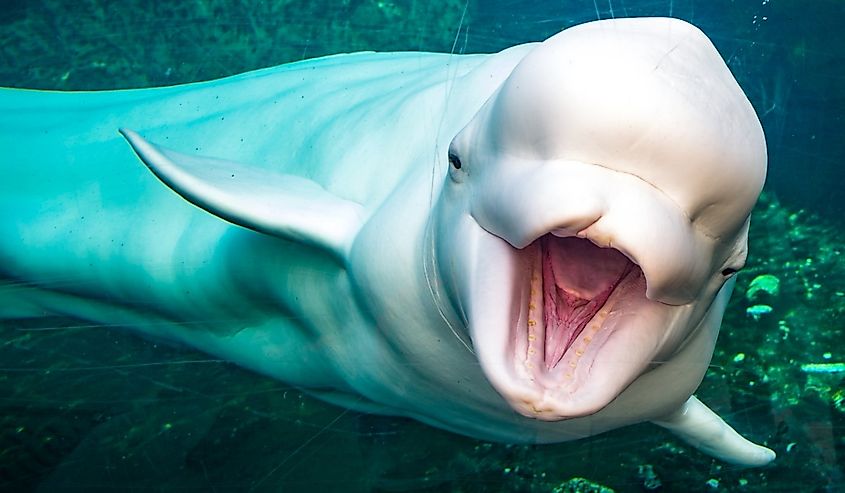
The beluga whale, one of the ocean’s cutest residents, is an animal loved by Canadians. Present throughout various waters, parks, and preserves, these Arctic and sub-Arctic cetaceans are the epitome of friendliness. Apart from their affable personality, belugas sport a cute and soft appearance. Their skin, for example, is white or whitish-grey and feels soft and rubbery to the touch. It covers their large size of up to 18 feet (5.5 m) and lumped forehead. The rest of the body is quite tapered until reaching the tail-fin, which creates an interesting silhouette that stands out in the water.
Along with appearance, many of the beluga whale’s quirks have interesting applications. For example, the fatty hump on their head contains an organ used for echolocation. Meanwhile, their white coloration is great for camouflage from predators like polar bears and killer whales in the Arctic ice. Beluga whales live in large social groups of up to 25 members, making hunting, playing, and socializing a group activity. Many of these groups live in Canada, which houses seven of the world’s 22 beluga whale stocks. However, they can shift around fast, with a top speed of over 12 miles per hour (20 km/h) in the water! Social groups will last for many years as these underwater mammals can live for dozens of years, with some reports claiming a lifespan of 80 years!
Bighorn Sheep (Ovis canadensis)
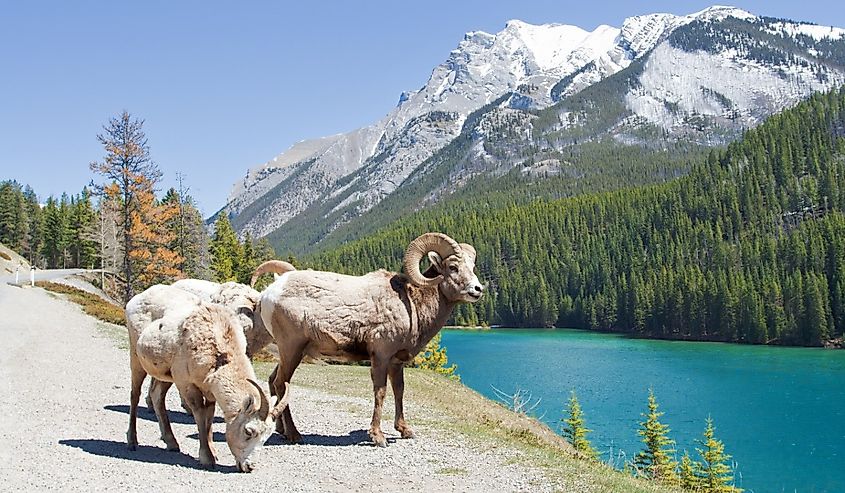
The bighorn sheep, named the provincial mammal of Alberta, lives throughout the Rockies, British Columbia, and Alberta. It is identified by the two large, curved horns that jut out of its head. Used for fighting predators, fighting other rams, and as an aide for eating, these horns are vital for a ram to thrive. Along with the horns, the average male is quite large, weighing between 128 and 315 pounds (58 and 143 kg) with a length of up to 62 inches (1.85 m). Despite their large size, these sheep are avid climbers and can easily scale steep cliffs. Moreover, they boast immense survivability and can live in various climates, from the hot deserts of Mexico to the chilling Canadian Rockies.
While Bighorn Sheep populations have dropped over the past few centuries, the species is still healthy. To this end, it is listed in the "Least Concern" category in terms of Conservation Status with thousands of individuals in North America alone. If you ever want to meet one of these sheep, be weary as they live in large herds and are quick to use their horns!
From razor-sharp teeth to rubbery skin, each of these animals has their own cool features to display. Bolstered by Canada’s diverse biomes, many creatures live and flourish in a natural habitat. Moreover, the local government has taken strong measures to save most species from extinction, including the bison, moose, and sheep. So, head out for a road trip and meet one of these cool animals (safe ones only) soon!







